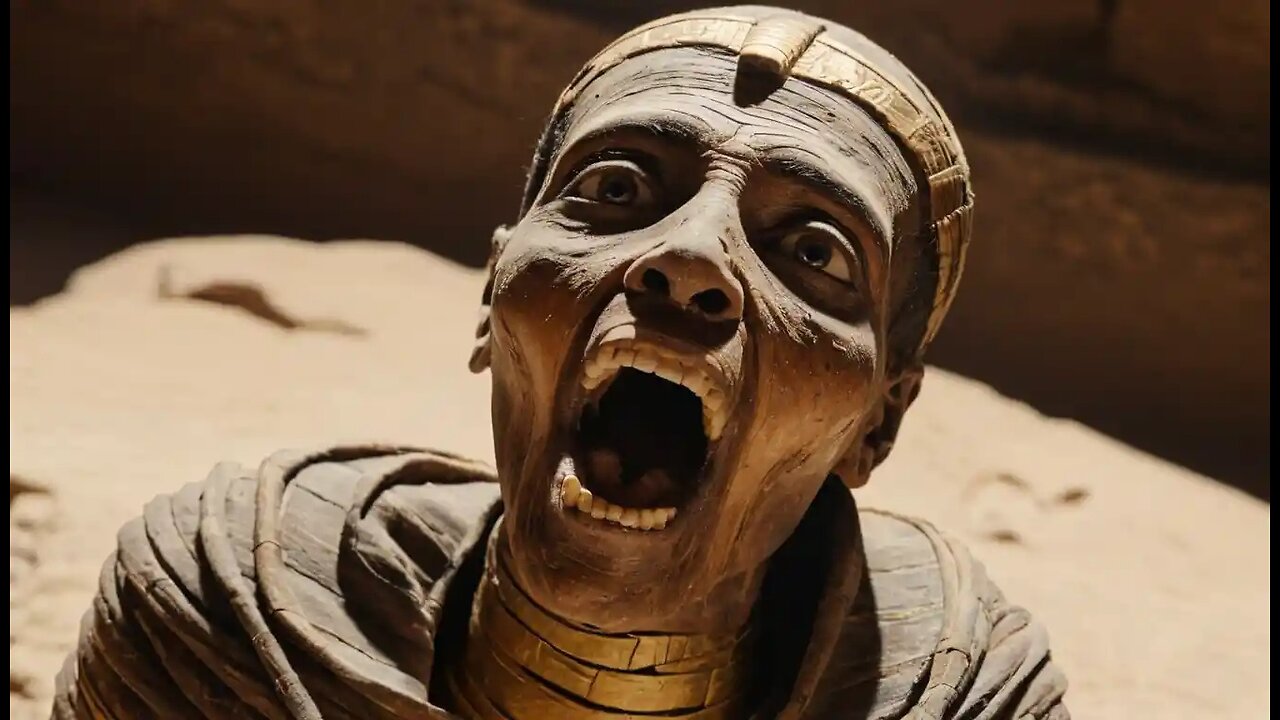Premium Only Content

Mummy Telling
Ancient Egyptians practiced mummification for millennia. Belief in an afterlife fueled this complex process. Preserving the body allowed the soul (ka and ba) to recognize it and live forever.
Early preservation was natural. Before 3100 BC (Predynastic Period), bodies buried in shallow desert pits dehydrated naturally in the hot sand, creating accidental mummies.
Intentional mummification began around 2600 BC (Old Kingdom). Embalmers removed internal organs susceptible to decay: stomach, intestines, liver, lungs. The heart, seen as the center of intelligence and emotion, remained. Organs were preserved, often placed in canopic jars. The body was dried using natron, a natural salt mixture. It was then anointed with oils and resins and wrapped tightly in layers of linen bandages.
Techniques improved during the Middle Kingdom (c. 2055-1650 BC). More care was taken with the body's treatment and wrapping. Facial features sometimes received more attention.
The New Kingdom (c. 1550-1070 BC) represents the apex of mummification artistry. Embalming was highly sophisticated. Brain removal, typically through the nose using hooks, became standard. The body cavity was cleansed. Natron dehydration lasted around 40 days, sometimes up to 70. Extensive wrapping included hundreds of yards of linen, amulets placed within layers for protection, and application of dark resin for preservation and sealing. Elaborate nested coffins and stone sarcophagi housed royal mummies like Tutankhamun and Ramesses the Great.
Later periods saw changes. During the Late Period and Greco-Roman times (after 664 BC), mummification became more widespread but techniques often simplified or varied. Quality sometimes declined, focusing more on the external appearance. Organs might be wrapped and replaced inside the body, or not removed at all. Subcutaneous packing created a more lifelike shape. Elaborate bandaging patterns and painted mummy portraits (Fayum portraits) became popular. Animal mummification vastly increased – cats, ibis, crocodiles, and bulls were mummified in huge numbers, often as offerings to gods.
The practice gradually faded with the spread of Christianity in the 4th century AD, which had different burial customs. Later, Islamic rule solidified its decline.
Egyptian mummies remain a powerful symbol of ancient Egypt. Their study provides invaluable information about health, diet, disease, technology, and religious beliefs of the past. They connect us directly to this ancient civilization.
Ancient Egyptians practiced mummification for thousands of years. Belief in an afterlife drove this complex ritual. Preserving the body allowed the soul to recognize it and achieve immortality.
Early preservation was natural. Before 3100 BC, bodies buried in desert pits dehydrated in the hot sand, creating natural mummies.
Intentional mummification emerged around 2600 BC (Old Kingdom). Embalmers removed internal organs like the stomach, intestines, liver, and lungs. The heart remained, considered the seat of intellect. Removed organs were preserved, often in canopic jars dedicated to protective deities. The body was thoroughly dried using natron, a natural salt compound found in desert lake beds. This dehydration process could take forty days or more. After drying, the body was anointed with oils and resins to keep the skin supple. It was then wrapped tightly in many layers of linen bandages, often hundreds of yards long. Resin was sometimes applied between layers to act as glue and sealant.
Middle Kingdom (c. 2055-1650 BC) techniques refined the process. Embalmers showed greater care in treating the body and wrapping. Facial features sometimes received more detailed attention, aiming for a more recognizable likeness of the deceased. Quality improved for those who could afford it.
The New Kingdom (c. 1550-1070 BC) marked the peak of mummification skill. Embalming became highly sophisticated, especially for royalty and nobility. Brain removal through the nose using long hooks was standard practice. The cranial cavity was often rinsed and filled with resin or linen. The body cavity was cleansed, disinfected with palm wine, and packed with temporary natron bundles, later replaced with linen, sawdust, or other materials to restore shape. Natron dehydration took around 40 days, ensuring thorough drying. Extensive wrapping involved hundreds of yards of linen. Protective amulets, like the scarab beetle, ankh, and Eye of Horus, were carefully placed within the bandages according to strict ritual prescriptions. Dark resin applied externally sealed and preserved the body, giving many mummies their characteristic blackened appearance. Royal mummies, such as Tutankhamun and Ramesses II, were placed in elaborate nested coffins and stone sarcophagi for maximum protection.
Later periods brought changes. From the Late Period into Greco-Roman times (after 664 BC), mummification became widespread, accessible to more social classes, but techniques often varied. Quality sometimes decreased, with more emphasis placed on external appearance rather than internal preservation. Organs might be wrapped individually and returned to the body cavity, or occasionally left inside altogether. Subcutaneous packing with mud, sand, or linen under the skin helped maintain a fuller, more lifelike form. Intricate, geometric bandaging patterns and realistic painted mummy portraits (especially during the Roman period in the Fayum region) became common, covering the face area. Animal mummification proliferated vastly; millions of cats, ibis, hawks, crocodiles, baboons, and other creatures were mummified, often as votive offerings to associated deities or as beloved pets.
#EgyptianMummy, #AncientEgypt, #Mummification, #Pharaoh, #Afterlife, #Egyptology, #Archaeology, #Tomb, #Sarcophagus, #History, #Preservation, #Embalming, #CanopicJars, #Natron, #LinenBandages, #Anubis, #Osiris, #Isis, #BookOfTheDead, #Hieroglyphs, #ValleyOfTheKings, #Tutankhamun, #KingTut, #RamsesII, #Pyramids, #NileValley, #AncientRituals, #DeathInEgypt, #Immortality, #KaAndBa, #EgyptianGods, #MuseumArtifact, #EgyptianHistory, #AncientCivilization, #MummyDiscovery, #TombsOfEgypt, #EgyptianBeliefs, #SacredAnimals, #AnimalMummies, #CatsOfEgypt, #IbisMummy, #CrocodileMummy, #SecretsOfTheMummy, #MummyScience, #Paleopathology, #EgyptianCulture, #MummyMask, #GoldMask, #Cartonnage, #Anthropology, #AncientTechnology, #Embalmers, #PriestsOfEgypt, #EternalLife, #EgyptianArt, #FuneraryArt, #Coffin, #Sarcophagi, #AncientBurial, #EgyptianMythology, #JourneyToAfterlife, #FieldOfReeds, #Underworld, #WeighingOfTheHeart, #Ammit, #Thoth, #Horus, #SonsOfHorus, #Duamutef, #Qebehsenuef, #Hapi, #Imsety, #MummyStudies, #AncientDNA, #CTScanMummy, #XrayMummy, #EgyptianAntiquities, #LostCivilization, #Giza, #Saqqara, #Luxor, #Karnak, #DeirElBahari, #BahariyaOasis, #GoldenMummies, #GrecoRomanEgypt, #FayumPortraits, #RosettaStoneContext, #MummyUnwrapping, #VictorianEgyptomania, #MummysCurse, #LegendVsReality, #ArchaeologicalDig, #EgyptsPast, #PreservedHistory, #LifeInAncientEgypt, #DeathRituals, #EternalEgypt, #AncientWorldWonders, #SacredTexts, #MummyResearch
#MummyMonday
#TombTuesday
#WaybackWednesdayEgypt
#ThrowbackThursdayEgypt
#PharaohFriday
#SarcophagusSaturday
#SundaySecretsEgypt
#AncientSecrets
#EgyptianMagic
#Amulets
#ScarabBeetle
#EyeOfHorus
#Ankh
#DivineFlesh
#MummyTombs
#Necropolis
#Thebes
#EgyptianHeritage
#WorldHeritageSite
#DesertSands
#TimeCapsule
#AncientMedicine
#EgyptianPriests
#RitualPurity
#OpeningOfTheMouth
#MummyPortrait
#RomanEgypt
#PtolemaicPeriod
#NewKingdomEgypt
#OldKingdomEgypt
#MiddleKingdomEgypt
#PredynasticEgypt
#NaturalMummification
#SandPreserved
#MummyUncovered
#EgyptMuseum
#CairoMuseum
#BritishMuseumEgypt
#LouvreEgypt
#MetEgypt
#AncientArtifacts
#HistoricalMysteries
#DecodingHistory
#MummyForensics
#Bioarchaeology
#HumanRemains
#RespectTheDead
#SacredBurial
#EgyptianSoul
#JourneyOfTheSun
#Ra
#SunGod
#MummifiedAnimals
#VotiveOfferings
#PetMummy
#SacredIbis
#SacredCat
#BaboonMummy
#MummysGold
#TreasuresOfEgypt
#TutankhamunsTomb
#HowardCarter
#LordCarnarvon
#CurseOfThePharaohs
#Egyptomania
#PopCultureMummy
#HollywoodMummy
#MummyMovies
#ConservingHistory
#DigitalMummy
#3DMummy
#VirtualAutopsy
#AncientHealth
#DietOfEgyptians
#DiseasesInAntiquity
#LifeExpectancyEgypt
#RoyalMummies
#QueensOfEgypt
#HatshepsutMummy
#AkhenatenMystery
#NefertitiMummySearch
#LostTombs
#UnsolvedMysteriesEgypt
#AncientCraftsmanship
#StoneWorkingEgypt
#TombDecorations
#WallPaintingsEgypt
#BookOfTheGates
#Amduat
#UnderworldBooks
#PapyrusScrolls
#AncientWisdom
#EternalRest
#LegacyOfPharaohs
#ExploreEgypt
#AncientWorldHistory
#MummyStudiesUpdate
-
 9:00
9:00
Zach Humphries
1 day agoXRP and CARDAO working together now?
46 -
 58:42
58:42
Sarah Westall
1 hour agoIt’s Big Big Money – Trafficking People is Intertwined in Business & Politics w/ Natly Denise
6.19K1 -
 LIVE
LIVE
LFA TV
11 hours agoLFA TV ALL DAY STREAM - TUESDAY 8/26/25
1,334 watching -
 1:49:34
1:49:34
The Quartering
4 hours agoToday's Breaking News With Melonie Mac & Hannah Claire Brimlow!
153K175 -
 23:16
23:16
Jasmin Laine
2 hours agoCarney HUMILIATED by German Reporter—CTV Host Laughs as Liberals Get DESTROYED on Air
11.9K12 -
 1:04:59
1:04:59
The HotSeat
2 hours agoLisa Cook Blocks Your Mortgage Relief While Committing Mortgage Fraud – YOU’RE FIRED!
15K10 -
 58:54
58:54
The Tom Renz Show
2 hours agoJudges Are Completely Immune From Lawsuits
9.54K -
 1:18:46
1:18:46
Awaken With JP
4 hours agoCracker Barrel Makes Brilliant Decision, Trump Bans Flag Burning and More - LIES Ep 105
56.8K34 -
 29:24
29:24
Stephen Gardner
2 hours ago🔥Trump PISSED! I can’t BELIEVE they did this!
19.3K30 -
 1:06:37
1:06:37
Sean Unpaved
5 hours agoCincinnati's Sack King Stays: Decoding the Deal & the NFL's Open-Ended Questions
49K